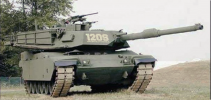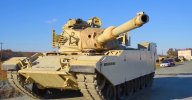Tuossa ketjussa oli linkki toiseen mielenkiintoiseen ketjuun jossa pohditaan, mitä T-62 tuominen rintamalle voisi tarkoittaa. Aika korkealentoista tekstiä, huomattavan paljon arvauksia kuten on pakko ollakin kun puhutaan Venäjän asevoimien toimintakuntoisten vaunujen määristä. Muistan lukeneeni Ukrainan tiedustelun tiedotetta, jonka mukaan vanhempien varusteiden ja vaunujen varastot olisi paremmasssa kunnossa kaluston osalta koska niistä on varastettu vähemmän. Vaikea sanoa, mutta jotainhan se tarkoittaa kun T-62 kaltainen vaunu toimitetaan sotatoimialueelle, vaikka sitten tukirooliin jonnekin kauas rintamalinjojen taakse. Jos heillä olisi valtavat määrät modernimpia vaunuja, oletan että toimittaisivat niitä mieluummin. Kijoittaja arvioi etteivät voi jättää Venäjän muita rajoja puolustamatta, minkä takia tietty määrä modernimpia vaunuja ei voida lähettää Ukrainaan. Oma arvio: tuon lisäksi näistä takalinjojen tukihommista saadaan vapautettua joku määrä vaunuja etulinjaan jos laitetaan vanhempi, huonompia vaunu niihin töihin:
LÄHDE
As background, RU is estimated by the ISS to have a total of ~2,900 T-72s, T-80s, and T-90s in active service with an additional ~10,000 of those types in reserve/storage (2021). Stratfor also estimates RU has 2,000 T-64s, 2,500 T-62s, and 2,800 T-55s in storage (2017).
This report leads to a damning implication. RU has potentially nearly exhausted its immediately operable reserves of T-64s, T-72s, T-80s, and T-90s. Frankly, there is absolutely no reason to deploy a T-62 if you have access to a more modern T-64, T-72, T-80, or T-90.
So how did RU get here? Ukrainian action on top of poor to nonexistent maintenance due to corruption. As of today (May 23), UA’s MoD estimates nearly 1,300 RU tanks have been destroyed. In addition to battlefield losses, it’s well documented that stored RU vehicles have been chronically unmaintained due to pervasive corruption.
Reports from UA Defense Intelligence indicate that up to 90% of stored RU tanks in at least one depot are non-operable. We can do some back-of-the-envelope math with all these figures. First, let’s assume UA’s estimate of RU tank loses is accurate. That means RU needs to replace at least 1,300 loses with tanks from its stores. Activating T-62s indicates they have <1,300 operable T-72/80/90s in storage. In other words, >87% are inoperable. Adding in T-64s, you get >89% of 12,000 stored T-64/72/80/90s are inoperable. Rounding to 90% inoperable and assuming the stored T-62s are not in worse condition, that means there are at most 250 operable T-62s out of 2,500 in storage. After that, RU will have to turn to T-55s. And if these numbers hold, there are at most only 280 operable.
Adding up all the stored tanks gives us 14,500 plus the 1,600 remaining in active service. With only 10% of the stored tanks operable, that gives a total of 3,050 remaining tanks that RU could deploy. I’m discounting the T-55s (I’ll eat a hat if they actually deploy them). Some implicit underlying assumptions. RU has not recovered, repaired, and put any loses back into service. If this is not true, then actual RU loses must be greater than UA claims and/or significantly more than 90% of stored tanks must be inoperable to explain the T-62s.
RU’s ability to produce additional tanks is also discounted as the two major tank factories in the country, Uralvagonzavod (UVZ) and the Chelyabinsk Tractor Plant (ChTZ), have reportedly halted production due to sanctions. It is also likely that not all the inoperable tanks will remain so. I think that they will be able to make some of them usable. However, this takes time and they will need to scavenge even more other tanks for parts and really only a small fraction can be made operational. The shutdown of UVZ and ChTZ will further hinder RU efforts to repair the inoperable tanks and efforts to repair tanks damaged in the field. Additionally, sanctions call into question RU’s ability to replace critical electronic components such as optics.
Now, addressing the other ~1,600 T-72/80/90s in active service. I’ve seen estimates that the initial invasion force contained ~1,200 tanks with ~400 as a reserve force based upon nominal RU TO&Es and assuming roughly full strength BTGs (almost certainly false). Working with these estimates and assumptions, RU has lost ~100% of the tanks it deployed with and ~25% of its reserve force for the invasion. What is interesting here, is that it seems that RU could just try to pull ~1,300 tanks from the 1,600 to replace losses.
But the report implies they haven’t, as T-62s are being activated for deployment to UA, not for deployment elsewhere to replace T-72/80/90s being redeployed to UA. Also, if they have redeployed the active tanks, that means actual RU loses would have to be nearly 2x larger than UA claims to justify the deployment of just the stored T-72/80/90s, let alone T-62/64s. I suspect the likely explanation is that Putin and the RU Gen. Staff. do not want to leave RU itself defended by T-62/64s while all the modern(ish) tanks are sent to UA.
Summary: Russia likely has at most ~3,100 deployable tanks before it has totally exhausted its active and operable stockpiled tanks. Given they have suffered ~1,300 loses in the first 3 months, I’m skeptical they can continue combat operations through the end of the year.
Key takeaway: We are witnessing the utter eradication of Russian armored forces by the Ukrainians and Russia’s own mismanagement of their military stockpiles. These losses are totally unsustainable and they may literally run out of usable tanks if the war drags on.







